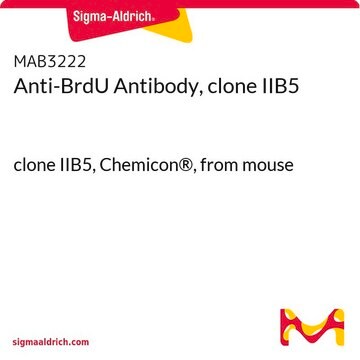MAB4072
Anti-BrdU Antibody, clone 131-14871
clone 131-14871, Chemicon®, from mouse
Sinónimos:
BrdU
About This Item
Productos recomendados
origen biológico
mouse
Nivel de calidad
forma del anticuerpo
purified immunoglobulin
tipo de anticuerpo
primary antibodies
clon
131-14871, monoclonal
reactividad de especies (predicha por homología)
all
fabricante / nombre comercial
Chemicon®
técnicas
flow cytometry: suitable
immunohistochemistry (formalin-fixed, paraffin-embedded sections): suitable
isotipo
IgG1
Condiciones de envío
wet ice
modificación del objetivo postraduccional
unmodified
Categorías relacionadas
Descripción general
Especificidad
Aplicación
Flow cytometry on 100μL of 106 cells: 1:5000.
Optimal dilutions must be determined by the end user.
IMMUNOHISTOCHEMICAL PROCEDURE
FOR PARAFFIN EMBEDDED TISSUE SECTIONS
STAINING PROCEDURE:
1. Deparaffinize sections in xylene 3 x 5 minutes. Resin embedded or GMA (Glycol methacrylate, 2-hydroxyethyl methacrylate) treated sections it is unnecessary to deparaffinize as there is no paraffin.
2. Place slides in graded alcohols (100, 95, 90%) to water at 2 minute intervals, and air dry. (Omit for GMA sections)
3. Circle sections with PAP pen or diamond pen to identify and dry thoroughly.
4. For GMA or resin sections, place slides in 0.5% Tween/PBS (pH 7.6) for 29 minutes.
5. Incubate in prewarmed (40°C) 1N HCl for 1 hour.
6. Wash 3 x 3 minutes with PBS (pH 7.6). Slides may be held at this point and the procedure continued the following day.
7. Incubate in 1X Trypsin solution (0.02-0.05% w/v, prewarmed to 40°C) for 20 minutes at room temperature for NBF (normal buffered formalin) fixed tissue or 10 minutes for Carnoy′s fixed tissue.
8. Wash 3 x 5 minutes with PBS (pH 7.6).
9. Incubate sections in 1% H2O2 (10 mL 30% H2O2 in 290 mL methanol) for 20 minutes, or GMA sections in 3% H2O2 (10 mL 30% H2O2 in 90 mL water) for 3 minutes.
10. Wash 2 x 2 minutes with PBS (pH 7.6).
11. Using the Vector ABC kit, add 3 drops of normal horse serum to 10 mL of PBS. Use this solution to block the slides for 20 minutes at room temperature.
12. Blot the slides of excess normal horse serum and incubate with MAB4072 diluted in PBS/BSA/Tween 20 for 1 hour at room temperature.
13. Wash 3 x 3 minutes with PBS (pH 7.6).
14. Add 3 drops of normal horse serum to 10 mL of PBS and then add 1 drop of biotinylated antibody stock. Incubate the slides with this diluted second antibody for 30 minutes at room temperature.
15. Prepare the Vectastain ABC Reagent by adding 2 drops of reagent A to 5 mL of PBS. Then add 2 drops of Reagent B to the same mixing bottle. Allow to sit for about 30 minutes prior to use.
16. Wash 3 x 3 minutes with PBS (pH 7.6).
17. Incubate the slides with ABC Reagent for 30 minutes at room temperature.
18. Wash 3 x 3 minutes with PBS (pH 7.6).
19. Prepare the substrate by mixing an equal volume of 0.02% H2O2 (made in distilled water from a 30% stock solution) and 0.1% DAB made in 0.1 M Tris buffer, pH 7.2. The H2O2 should be freshly prepared from concentrated stock. Because many peroxide substrates are unstable in the presence of H2O2 or when exposed to light, the substrate should be prepared just prior to use. Since DAB is a suspected carcinogen, care should be taken in handling and disposing of all peroxidase substrates.
20. Stain the slides with DAB substrate for 2-5 minutes.
21. Wash 2 x 2 minutes with distilled water.
22. Counterstain with hemotoxylin, dehydrate through xylene, and mount the coverslip.
Epigenetics & Nuclear Function
Cell Cycle, DNA Replication & Repair
Forma física
Almacenamiento y estabilidad
Nota de análisis
Brdu treated cells
Otras notas
Información legal
Cláusula de descargo de responsabilidad
Not finding the right product?
Try our Herramienta de selección de productos.
Código de clase de almacenamiento
12 - Non Combustible Liquids
Clase de riesgo para el agua (WGK)
WGK 2
Punto de inflamabilidad (°F)
Not applicable
Punto de inflamabilidad (°C)
Not applicable
Certificados de análisis (COA)
Busque Certificados de análisis (COA) introduciendo el número de lote del producto. Los números de lote se encuentran en la etiqueta del producto después de las palabras «Lot» o «Batch»
¿Ya tiene este producto?
Encuentre la documentación para los productos que ha comprado recientemente en la Biblioteca de documentos.
Los clientes también vieron
Nuestro equipo de científicos tiene experiencia en todas las áreas de investigación: Ciencias de la vida, Ciencia de los materiales, Síntesis química, Cromatografía, Analítica y muchas otras.
Póngase en contacto con el Servicio técnico











